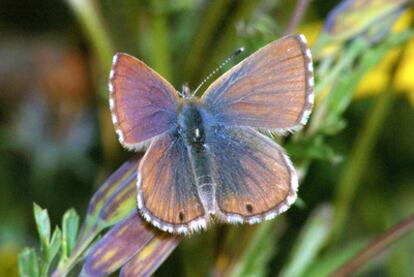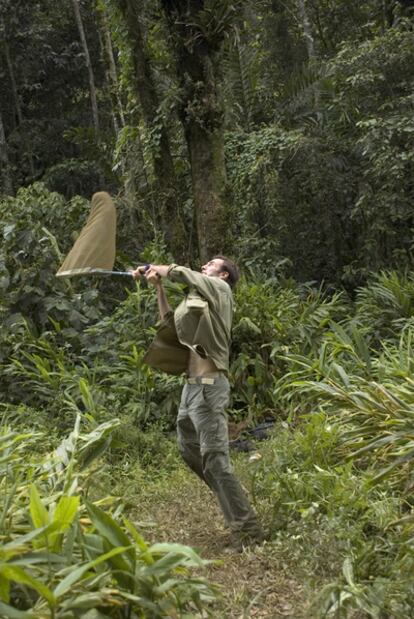A Catalan Indiana Jones on the trail of Nabokov's butterflies
Roger Vila has been finishing off the job begun by the author of 'Lolita'
The gusts of wind were strong that morning at the Agua Negra mountain pass. Roger Vila had made it all the way to this formidable enclave on the border between Argentina and Chile in search of a particular genus of blue butterfly: the Pseudolucia penai. Finding them occasionally requires climbing to an altitude of more than 4,500 meters, and as he was trekking along that clear, majestic landscape of ice, Vila came across a few plants that had barely managed to push their way up through the snow. On one of the leaves, two blue butterflies were copulating while hanging on to the plant as best they could, their wings bent backward by the wind.
"They were making love," says Vila, a biochemist who earned his doctorate at Harvard, sitting comfortably in a Victorian-looking armchair. For this 37-year-old Catalan, blue butterflies are something more than just a flying insect. They are his lifelong passion and the object of his research, to which he has dedicated seven years of his life. The passion was inspired by Vladimir Nabokov, the author of Lolita and one of the greats of 20th-century literature, as well as a reputed entomologist. "He made the first known classification of blue butterflies in the New World," he notes.
By following Nabokov's footsteps - and using DNA sequencing - Vila is trying to determine whether, just like the Russian-American author said, blue butterflies reached the New World by crossing the Strait of Bering. In one month, the results of his research will be published in the scientific journal Proceedings of the Royal Society . Until then, nobody will know whether Nabokov was right or wrong.
On a recent Wednesday morning, Vila produced a laser pointer from his pocket and embarked on a talk about the chemistry of aphrodisiacs in butterflies at the BBVA Foundation on Madrid's Paseo de Recoletos. The conference was part of a biodiversity symposium organized by the foundation and the Evolutionary Biology Institute (IBE). The first factor that comes into play in butterfly attraction, he explained, is sight; and then chemistry. "Just like humans," he added, drawing a few smiles from a crowd where ties were as plentiful as hiking boots.
Vila's job consists of exploring, obtaining specimens and sequencing their DNA - which means he needs both a lab coat and an Indiana Jones hat. He arrived in Harvard in 2003, partly through persistence and partly through the inestimable help of Naomi Pierce, a leading entomologist at the Ivy League university who temporarily put up the young biochemist from Catalonia after he sent her samples from Barcelona. He had come to the right place at the right time. Three taxonomists - one from Israel, one from Hungary and one from the US - had taken up Nabokov's legacy and were searching for another entomologist to help them test the author's theories on blue butterflies.
Vila still remembers the excitement he felt on the day he walked into Nabokov's former office at Harvard. "There was his work table, frozen in time," he says, with shining eyes. Nabokov worked as a curator of the butterfly collection at Harvard's Zoology Museum in the 1940s, and that is where his legacy remains. There are several genera of blue butterflies named in his honor, such as Pseudolucia Humbert , a tribute to the tormented professor who watches the child lying in the garden in Lolita ; the Pseudolucia Charlotte , a reference to the mother of that object of desire; and the Nabokovia.
"Nabokov was a great taxonomist," says Vila. "He was a pioneer of morphometry [classifying by shape]. He would look at the butterfly's genitalia, one of the keys of taxonomy. Some people made fun of him, and asked him if that was the result of his obsession with genitalia, since he'd written Lolita ..."
The Catalan researcher has 5,000 butterflies stuck with pins at home. Besides that, he has more than 13,000 specimens - those he uses for DNA sequencing - preserved in ethanol at the lab. He learned how to draw butterflies before he learned how to write. By the age of nine he was already a member of the Catalan Society of Lepidopterologists, and at 10 he was asking his parents to explain some of the complex articles published in scientific journals. "When it comes to that, Nabokov and I are the same," he says. "I have seen photographs of him in Russia, dressed like a little sailor and studying butterflies."
What the three taxonomists from Harvard proposed was that Vila spend three years of his life trekking across South America looking for blue butterflies and collecting the largest possible number of species. It is obvious what his reply was. Seven years of work and several thousand dollars later - Vila will not disclose the specific amount - the result of this scientific adventure is encouraging. We do not know whether Nabokov's thesis was correct, but along the way, the team has sequenced the DNA of 78 different species of blue butterflies, mapping out their genetic information to obtain in-depth knowledge about their particular traits in a way that had never been achieved before through mere observation.
Every mission conceals a challenge that is the yardstick by which excellence is measured. In Vila's project, that challenge had an evocative name: "Eldoradina." In 2006, the fieldwork was coming to an end. The team had collected 77 specimens of blue butterfly, but one had eluded them. Three times they had traveled to Peru to find it, and thrice they had returned with empty hands. They were about to give up, when there was an unexpected stroke of good luck: "Roger, take these 2,000 euros, spend two weeks in Peru and try one more time. You can only take one person with you," said Mr Putman, a wealthy philanthropist.
Rod Eastwood, an Australian who happens to be one of the best entomologists in the world, was the chosen one. Together, he and Vila drove 4,000 kilometers across Peru, coming across all sorts of butterflies except for Eldoradina . "Running at an altitude of 4,000 meters was really tough," Vila recalls. "At first you are dizzy and exhausted." Catching butterflies is no easy task - a subtle flick of the wrist is needed. The two weeks were up, and on their last day, Eastwood and Vila decided to sleep in a mining town at 4,500 meters of altitude. There was not one Eldoradina in sight. On their way back to Lima, they noticed a butterfly watering stop near a hiking trail and stopped to explore. Each man followed the brook a different way, one upstream and the other downstream. As Vila walked along, he suddenly saw an Eldoradina alighting on a puddle. He sneaked up on it slowly, his net firmly in hand. He felt his stomach doing somersaults and thought: "If you fail and it gets away, you'll return to Harvard like a loser." Bam! It was caught.
The snakes that crossed his path, the lush Brazilian bamboo forests that left his hands in shreds, and the time when he overestimated his own abilities and gave his partners a scare by venturing off alone into the mountain, were all behind him.
"I saw the butterflies that Nabokov was unable to see in South America," concludes Vila, whose research contract runs out in September 2011. "And I have learned the answers to things that he thought to be true."


Tu suscripción se está usando en otro dispositivo
¿Quieres añadir otro usuario a tu suscripción?
Si continúas leyendo en este dispositivo, no se podrá leer en el otro.
FlechaTu suscripción se está usando en otro dispositivo y solo puedes acceder a EL PAÍS desde un dispositivo a la vez.
Si quieres compartir tu cuenta, cambia tu suscripción a la modalidad Premium, así podrás añadir otro usuario. Cada uno accederá con su propia cuenta de email, lo que os permitirá personalizar vuestra experiencia en EL PAÍS.
¿Tienes una suscripción de empresa? Accede aquí para contratar más cuentas.
En el caso de no saber quién está usando tu cuenta, te recomendamos cambiar tu contraseña aquí.
Si decides continuar compartiendo tu cuenta, este mensaje se mostrará en tu dispositivo y en el de la otra persona que está usando tu cuenta de forma indefinida, afectando a tu experiencia de lectura. Puedes consultar aquí los términos y condiciones de la suscripción digital.
Últimas noticias
Most viewed
- Alain Aspect, Nobel laureate in physics: ‘Einstein was so smart that he would have had to recognize quantum entanglement’
- Alvin Hellerstein, a 92-year-old judge appointed by Bill Clinton, to preside over Maduro’s trial in New York
- Gilles Lipovetsky: ‘If you want to live better and fall in love, take Prozac, don’t look to philosophy’
- Cuba confirms death of 32 of its citizens in the US attack against Venezuela
- Why oil has been at the center of Venezuela-US conflicts for decades








































